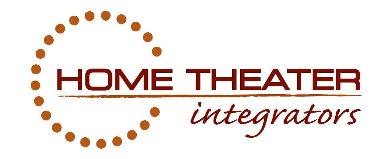What's new in the HDMI 1.4 specification?
HDMI Ethernet Channel
The HDMI 1.4 specification adds a data channel to the HDMI connection, enabling high-speed, bi-directional communication. Connected devices that include this feature can send and receive data via 100 Mb/sec Ethernet, making them instantly ready for any IP-based application. The HDMI Ethernet Channel allows internet-enabled HDMI devices to share an internet connection via the HDMI link, with no need for a separate Ethernet cable. It also provides the connection platform that will allow HDMI-enabled components to share content between devices.
Audio Return Channel
The new specification adds an audio channel that will reduce the number of cables required to deliver audio "upstream" from a TV to an A/V receiver for processing and playback. In cases where a TV features an internal content source, such as a built-in tuner or DVD player, the Audio Return Channel allows the TV to send audio data upstream to the A/V receiver via the HDMI cable, eliminating the need for an extra cable.
3D
The 1.4 version of the specification defines common 3D formats and resolutions for HDMI-enabled devices, enabling 3D gaming and other 3D video applications. The specification standardizes the input/output portion of the home 3D system, facilitating 3D resolutions up to dual-stream 1080p.
4K Resolution Support
The new specification enables HDMI devices to support extremely high HD resolutions, effectively four times the resolution of a 1080p device. Support for 4K allows the HDMI interface to transmit digital content at the same resolution as the state-of-the-art Digital Cinema systems used in many movie theaters.
Expanded Support For Color Spaces
HDMI now supports color spaces designed specifically for digital still cameras, enabling more accurate color rendering when viewing digital photos. By supporting sYCC601, Adobe®RGB, and Adobe®YCC601, HDMI display devices are capable of displaying more accurate, life-like colors when connected to a digital camera.
HDMI Micro Connector (Type D)
The HDMI Micro Connector is a significantly smaller 19-pin HDMI connector supporting up to 1080p resolutions for portable devices such as cell phones, portable media players, and digital cameras. This new connector is approximately 50% smaller than the size of the existing HDMI Mini connector.
Automotive Connection System (Type E)
The Automotive Connection System is a cabling specification designed to be used for in-vehicle HD content distribution. The HDMI 1.4 specification provides a solution designed to meet the rigors and environmental issues commonly found in automobiles, such as heat, vibration and noise. Using the Automotive Connection System, car manufacturers now have a viable solution for HD distribution within a vehicle.
When should we expect to see products with some of these new features?
While the HDMI Licensing authority has no special insight into manufacturers' product plans, prior experience tells us that when a new version of the specification is released, products featuring the new capabilities typically start to reach the market within six to nine months. A number of products featuring HDMI 1.4 functionality are likely to be introduced at the 2010 Consumer Electronics Show in Las Vegas.
Are manufacturers required to implement all of the new HDMI 1.4 features?
No. HDMI technology is designed to enable a wide variety of manufacturers in different markets to implement the feature sets that work best for their customers.
How will I know which HDMI 1.4 features are implemented in a device?
Shop for the specific features that interest you, rather than shopping for an HDMI version number and assuming that a certain feature is supported. Since many of the capabilities detailed in the HDMI 1.4 specification are optional implementations, it's the responsibility of the manufacturer to tell you what features are supported in any given device.
Will any of the new HDMI 1.4 features require a new cable?
The HDMI Ethernet Channel feature will require a new cable that supports this functionality, either a Standard HDMI Cable with Ethernet or a High Speed HDMI Cable with Ethernet, depending on the maximum resolution to be supported. The Automotive Connection System will also employ a new class of cable, the Standard Automotive HDMI cable, which is designed specifically for automotive use. All of the other new HDMI 1.4 features will be compatible with the existing categories of cables.
Are HDMI 1.4 devices going to be backwards-compatible with older HDMI (v.1.0 - 1.3) devices?
Yes, devices built to the HDMI 1.4 specification will be fully backwards-compatible with existing HDMI devices and their features.
Can older HDMI (v.1.0 - 1.3) devices be firmware-upgraded to take advantage of the new features introduced in HDMI 1.4?
Probably not. Most of the new features introduced in HDMI 1.4 will require a new HDMI chip to enable, and cannot be upgraded via firmware.
Miscellaneous
Where can I find more information about HDMI 1.4?
For general questions about HDMI, please visit www.hdmi.org. For complete details on the HDMI 1.4 specification, please go to http://www.hdmi.org/manufacturer/hdmi_1_4.aspx.
Marc
www.HomeTheaterIntegrators.com
